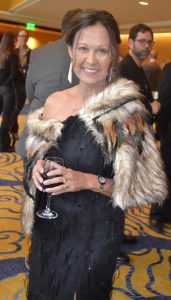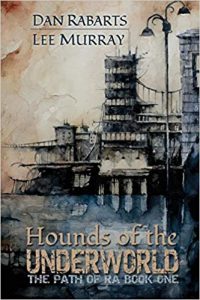Please note: this is part two of our interview with Lee Murray. Please click here for part one.
Lee Murray is an award-winning New Zealand author of science-fiction, fantasy and horror. She recently won the Sir Julius Vogel Award for Best Novel with Into the Mist, book two of the Taine McKenna series, as well as Best Collected Work as one of three editors on Te Korero Ahi Kā. However Murray’s work isn’t limited to the page: she has also helped establish key writing communities in New Zealand and organise events such as GeyserCon, New Zealand’s 40th National Science Fiction and Fantasy Convention.
To learn more about Murray’s work, check out her website here — or part two of our interview below. Enjoy!
The Path of Ra series is also a distinctly New Zealand work. Have you received much feedback from both local and international readers in regards to the story’s setting or language?
The Path of Ra is a collaborative series which I co-author with my friend and colleague, Dan Rabarts. Having already worked together with some success on a couple of anthology projects, Dan and I decided to join forces, taking a he-said / she-said approach to a futuristic supernatural thriller. When we started working on the novella — yes, it was going to be a novella and it accidentally turned into a three-book series — with both of us being Kiwi, there was no doubt that we would set our story in New Zealand. We selected a near-future Auckland as the setting, partly for its geography, its sprawling urban spread, and especially for its recognisable landmarks such as One Tree Hill, the Auckland Harbour Bridge, the downtown waterfront, and the iconic Sky Tower. As far as feedback from our readers about the setting and language goes, here’s what some of them had to say:
“The descriptions of the scenes, including a dark version of Auckland and the surrounding countryside, really worked for me.”
“…a fast-moving futuristic novel with a great New Zealand flavour and supernatural thrills on the side.”
“Setting the novel in near future New Zealand is so brilliant! I’ve never read another novel with that setting, so it feels fresh in a genre that frequently feels overused and stale.”
“The unusual setting in a bleak near-future New Zealand added to the dark atmosphere. Also, it was interesting to learn several New Zealand and Māori phrases, thanks to the glossary thoughtfully added at the end of the book.”
“Set in the Auckland of the future, an energy-starved darker version of itself, the story manages to seamlessly combine a nod to culturally insightful supernatural elements with the clarity that only science can provide.”
I think, when we read fiction, we like to be transported to somewhere fresh and exotic, as Roald Dahl writes in Matilda: “…books transported her into new worlds and introduced her to amazing people who lived exciting lives.” For our Path of Ra stories, Dan and I believed that Auckland in the 2040s could be that new world, a city sweltering though the effects of rapid climate change where fuel and food shortages have an impact on everyday lives, and where the underworld draws inexorably nearer. Our readers seem to like it.
In terms of language, our tendency to use Kiwi vernacular in our writing has proved to be very entertaining during the editing process. For example, when we submitted Hounds of the Underworld to the publisher, our editor mentioned a possible Freudian slip. Did we know that Penny had called for the laboratory fume hoods to be turned up full tit? Shouldn’t that be full tilt? New Zealand is the only country in the world to use that particular turn of phrase. We love providing that uniquely Kiwi context by adding words like chur, ropeable, and Weet-Bix to our stories. We also love that after working with us for three years, our American publisher immediately knows what we mean when we talk of whānau, whāngai, and wairua. Using these local terms allows New Zealand readers to recognise the backdrop as being distinctly Kiwi, while also offering a fresh landscape for our international readers.
However, when we use these terms, we’re careful to provide context, so the word is understood, making the reading experience an enjoyable one, without overly taxing the reader. It’s one thing to provide a strong Kiwi flavour, and another to clobber your reader over the head with it. Sometimes though, we’ll change a term to something simpler, just to avoid a reader stumbling over an unfamiliar expression in a crucial scene. For example, in an early draft of Teeth of the Wolf, my character, Penny, mentions that Cerberus was ‘full of beans’, and our editor questioned why the Labrador was fed just a page later. In the final text, we agreed that the dog should be full of energy, since no actual beans were consumed! Happily, our publisher, Raw Dog Screaming Press, is hugely supportive of diverse voices, and I suspect the company’s focus on authenticity is, in part, the reason the house was awarded this year’s international Horror Writers Association’s Specialty Press Award.
You were the programme director at GeyserCon this year – what did the role involve? (And were you able to enjoy the convention as a fan as well?)
Being programme director for one of our national science fiction and fantasy conventions means around two years of weekend volunteer work — and a willingness to relinquish your soul. I’m kidding, of course, although not when it comes to the amount of work. Mostly, the role involves being completely potty about science fiction, fantasy, and horror, and having the connections and the firepower to persuade, cajole, or press-gang your colleagues into sharing their talent and their expertise. After that, it’s simply a matter of ensuring your panellists and presenters offer topics and activities that you’d be excited to attend yourself. So, despite the fact that I was running around like a headless chicken checking on things most of the weekend, I got to experience a lot of the activities and discussions on offer. I can honestly say GeyserCon was a wonderful experience.
This year’s event included cosplay and gaming streams, as well as an industry stream for writers, screenwriters, and poets. The presentations included fight scenes, writing from found objects, designing fantasy maps, planning for a geothermal apocalypse, designing Victoriana costumes from op shop materials, cosplay make-up, gaming for kids, creating zines, and a hilarious horror-thriller debate. Fans of science fiction, fantasy, and horror were simply spoiled for choice. One of the best things about our national conventions is that with just 200-300 attendees, the numbers aren’t too overwhelming, which makes them a good opportunity for introverted geeky sorts like me to network with friends, catch up with new trends, and generally immerse themselves in all things genre. I almost always come home with more books than I have time to read, too.
For part three of our interview with Lee Murray, please click here.



